Sometime in 1657 two Spanish salvage ships were wrecked off the shores of Gorda Cay, a thousand-acre island just west of Great Abaco and north of the Bahamas.1 The ships had been moving silver recovered from the galleon Nuestra Señora de la Maravillas, which itself had been wrecked the year before. The survivors buried their treasure on the island, retrieving what they could a year later. The rest lay undisturbed for almost four centuries.
In 1947 a storm rearranged the beaches of Gorda Cay, revealing in its aftermath evidence of the wreck to local fishermen. One year later, an American diver found three silver bars off the coast. Two years later, two Nassau businessmen-turned-divers claimed to discover another silver bar in the ballast piles of the wreck—although local rumor had it that they simply bought the piece from a fisherman for fifty dollars.
In 1957, 150 acres of Gorda Cay was acquired by the Trinidadian real estate developer and entrepreneur Alvin Tucker.2 Tucker, an aviation enthusiast, built a 2400-foot tarmac runway on the cay. If he ever harbored ambitions of permanently inhabiting the cay, however, they would be dashed in the following years by the news that the airstrip had been commandeered by narcotics traffickers. With the local authorities reportedly compromised, and Tucker’s caretaker bought off with a bottle of rum (amicably or otherwise), the narcos would ship their product from South America by sea before sending it on planes bound for Florida. By the time Tucker sold the land to lawyers representing a company called Leisure Club Ltd. in the early seventies, he had stopped visiting the island for fear of his life.
Leisure Club Ltd. was, of course, a front for one of these narcos: an American named Frank Barber. After securing the cay, Barber consolidated his smuggling enterprise, renting the airstrip to other narcos, shipping his own product, and laying plans for a hotel complex. The first bust was in 1977.3 Barber was himself arrested in 1982, allegedly in possession of 1.8 million Quaalude tablets, but not before becoming an informant for the DEA and squealing on other drug smugglers as well as his own DEA supervisor (one Jeffrey I. Scharlatt), who had stopped reporting certain shipments and started distributing narcotics himself.4
Barely a year having elapsed since Barber’s arrest, film crews began to arrive to shoot key scenes of the romantic comedy Splash, starring Tom Hanks and Daryl Hannah—the first production of the recently established Touchstone Pictures, the more adult-oriented studio of the Walt Disney Company.
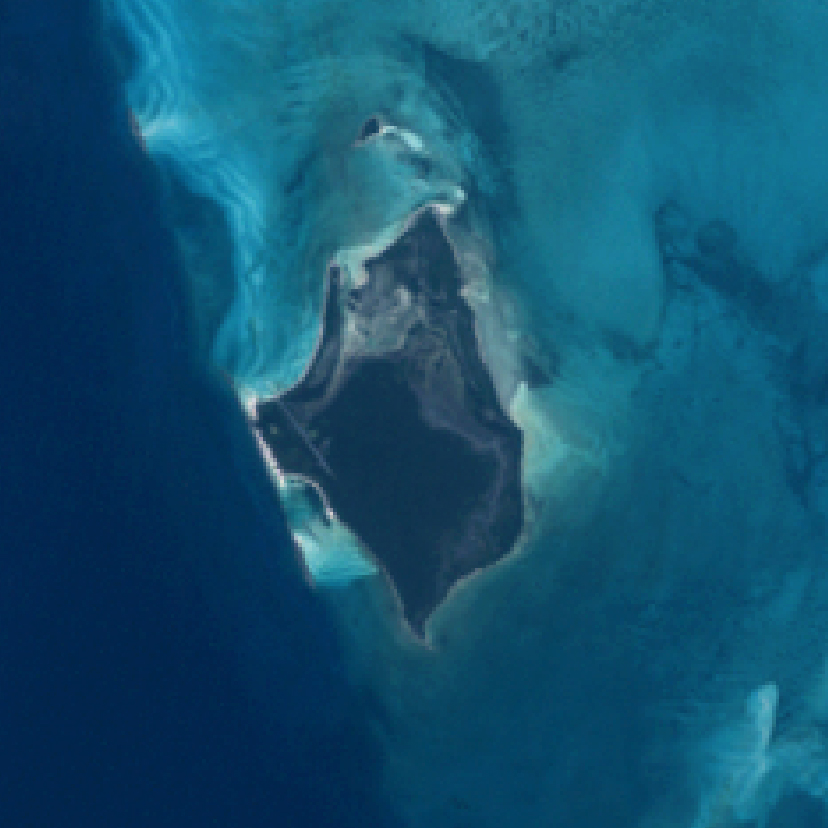
Today Disney’s presence in the Bahamas goes beyond mere film shoots. Rather, the company has managed to make the territory its stage for a more exacting and fastidiously produced apparatus comprising both a fleet of cruise ships and a resort on a private island to which its ships are sent. This island is, of course, Gorda Cay (now renamed Castaway Cay), but its histories have been suppressed in a bid to keep the Disney brand—along with its requisite narratives and conditions of total hermeticity—intact. Yet even as Disney has sought to do so, it has continued the practices of Gorda Cay’s former rulers. Just as narcos hijacked Tucker’s airfield for their own criminal enterprise, Disney has terraformed the island’s shores to accommodate the deep hulls of cruise liners. Just as Barber was abetted by corrupt local authorities as well as a compromised DEA, Disney has made use of the dubious legal infrastructure by which ships are governed.
The smoothness and efficacy of Disney’s operation stand in stark contrast to the operations of other US companies, who have actively embraced and fetishized the narco past of the archipelago.5 It may in part be this smoothness, doubtless informed by the company’s decades of experience managing its terrestrial holdings, that has kept the operation from any damaging exposure. But successful or not, exposed or sustained in broad daylight, these companies are united in the practice of narrative displacement, one that implicates their customers and depends on the traffic of untruths, the condition of enforced hermeticity, and the erasure of memory.
The Fleet
No longer constituting formal expressions of the technology that produced them, liners have become experiential landscapes centered entirely on the needs of the user.6
The Walt Disney Company had run cruises to the Bahamas out of Port Canaveral using leased vessels (some of them converted ocean liners) since 1986. This arrangement, however, frustrated the kind of total control the company executes over its terrestrial holdings, such as the hotels on the grounds of its theme parks, and by 1998 the first Disney-built Magic-class cruise liners had set sail.7 The Disney Magic (83,000 gross tonnage) was followed by a series of others: the second Magic-class Disney Wonder (83,000 GT) in 1999, the first Dream-class ship Disney Dream (130,000 GT) in 2011, and the second Dream-class ship Disney Fantasy (130,000 GT) in 2012.8 The company has ordered another three vessels to join the fleet, approximately 140,000 GT each, and expects to commission them in 2021, 2022, and 2023 respectively.9
Formally Disney’s ships share as much with the ocean liners of the first half of the twentieth century as Disney “imagineering” will allow. Mike Reininger, Disney’s vice president of product development at the time of the launch of the Magic, explained, “We wanted the boat’s look to rekindle the spirit of the great classics but at the same time to look absolutely contemporary.”10
All four currently operating vessels feature a black-painted hull (characteristic of almost any liner before the switch from coal to oil as fuel), a white superstructure, teak decks, and art deco (or art nouveau, depending on the vessel) revivalist interiors.11 Their lifeboats, while constructed out of fiberglass, are molded to look as though made of wooden planks. They are colored a mustard yellow to better match Mickey Mouse’s color scheme (something that required a waiver of maritime law, the story goes, which requires a “durable fluorescent” or similarly visible color).12 All four ships feature a dummy funnel to better afford symmetry to the ships’ silhouettes. Even as elements of a colossal, pantomime architecture, Disney’s superficial reproduction of historic objects keeps with the spirit of old liners—RMS Titanic was one of many other ships to also boast a dummy funnel for almost no other reason than to conform to a certain ideal image of the liner.13
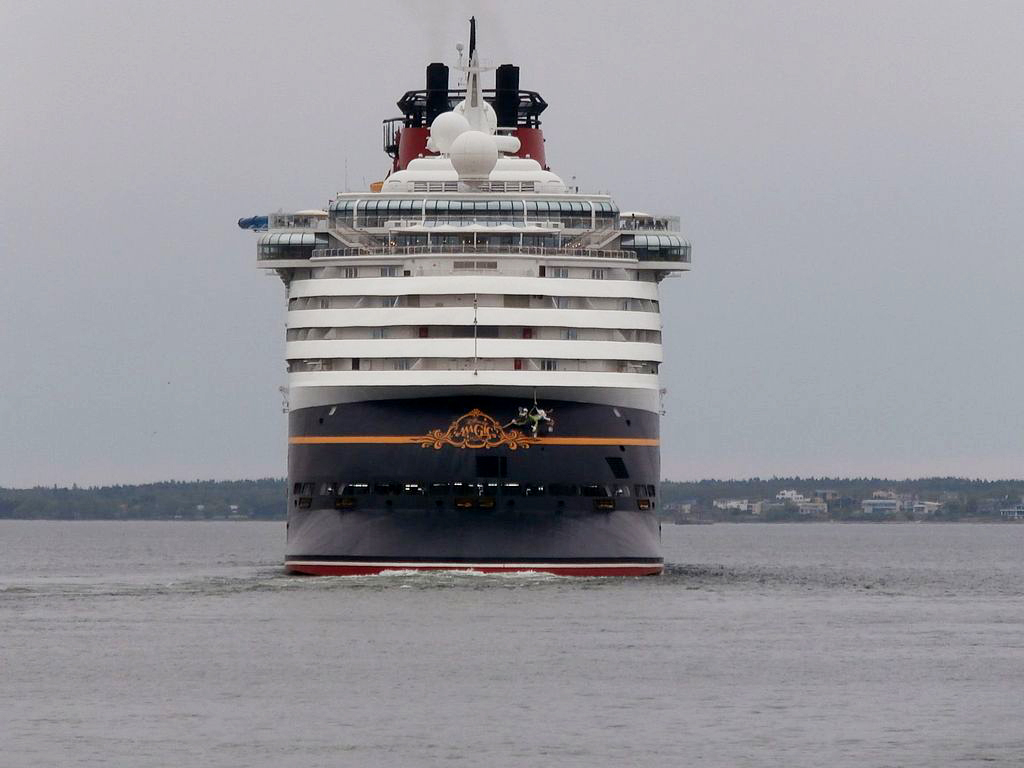
Reininger’s apparently paradoxical ambition helps to explain why, in addition to maritime engineers, the company employed frog, an electronics design team from Silicon Valley (to make the design of each ship “less about maritime architecture and more about package design”) as well as Arquitectonica, the Miami-based firm responsible for the high postmodernist Atlantis Condominium and a slew of casinos.14 The practice of employing well-established architects and interior designers at sea was pioneered by the ocean liners of the past—that Disney should choose an architecture firm known for its sardonic, histrionic approach to architecture speaks to Disney’s understanding of what is “contemporary” as well as architecture’s understanding of itself at the end of the twentieth century. Indeed, Disney had already been a major corporate sponsor of Arata Isozaki, Frank Gehry, and Michael Graves—the latter of whom would engage in his own form of (ultimately unadopted) character design through the Walt Disney World Swan and Walt Disney World Dolphin hotels. Only such postmodernism could have so suitably delivered the masquerade, self-referentiality, and subterfuge demanded by Disney, the company so widely found responsible (even in its eclipse) for the industrialization of storytelling in the twentieth century.15
Consider the following offers onboard the Disney Dream. From your very own stateroom (the name Disney gives to its suites) you may use the ship’s internal phone system to dial stateroom 5148½ to reach the voicemail of Muppet Pepé the King Prawn, who will tell you the “joke of the day.” Pepé also appears alongside other Muppet friends, like Kermit the Frog, in the Midship Detective Agency, an electronically-assisted onboard treasure hunt that makes use of the ship’s “enchanted art” (faux-historic fittings and consoles with LCD screens). Both experiences are possible because Disney acquired the rights to the Muppets from The Jim Henson Company in 2004 for US$75 million. On Deck 5 there is the Star Wars Millennium Falcon: an interactive space comprising mockups of the namesake ship’s cockpit and galley with other props, soundscapes, and games lifted from the original franchise (again only possible given Disney’s acquisition of Lucasfilm in 2012 for US$4.02 billion).16 Also on Deck 5 is the Infinity Room, which features games, props, and merchandise from the Disney sandbox game of the same name and is itself outfitted with other characters from the Marvel Cinematic Universe (acquired in 2009 for US$4 billion), Star Wars, Pixar (US$7.4 billion), as well as original Disney characters.
No amenity on board the Dream, however minor, is without a theme, which in a more or less spurious way can be bootstrapped to the Disney canon. The colossal LED screen attached to the rear of the forward funnel is called Funnel Vision; the sports arena on the top deck, Goofy’s Sports Deck; the paddling pool, Nemo’s Reef; the waterslide on the top deck, the AquaDuck; the nursery, It’s a Small World. Disney motifs are worked into the carpets and floor tiles, railings, statues, chandeliers. Each ship sports a different Disney character as a figurehead on its stern; each funnel is adorned with Mickey Mouse ears; and each of the four or five pools onboard, being a series of intersected, variously sized circles in plan, recall Mickey’s emblematic ears.
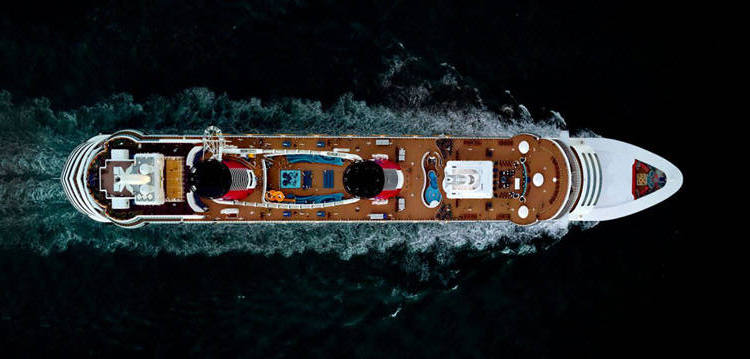
This is because Disney’s brand identity rests not only on a panoply of narratives but on the total spatialization of these narratives, their relentless merchandizing, and the labor of the company’s staff.17 This totality is temporal as well. As with their more terrestrial experiences, maritime Disney is a perpetual spectacle—from the moment you step aboard the Dream and are applauded by a line of staff members to the See Ya Real Soon Farewell Show that entertains you while you wait for the hull door to open back in Port Canaveral. This perpetual spectacular is modulated by the ship according to a kind of “spectrum” of participation.18 At the one end, a passenger can opt for a form of “passive” interaction, which requires no input on their behalf. At the other, one can actively take part in the programming on board, such as visiting the Bibbidi Bobbidi Boutique where children are “made over” as a prince or princess (according to Cruise Mapper, prices for girls range from “US$59.95 including makeup, hairstyling, nail polish, tote, and sash, to US$194.95 including all aforementioned services, princess dress, wand, and crown that can be taken home”).19 Somewhere in the middle are the passengers who indulge the staff in Disney character costume who periodically appear, accompanied by a photographer, for Disney Character Greetings—twenty digital photos can be pre-booked for US$250.20 Armed with knowledge that they can outsource childcare to the ship’s stewards, adults often let their kids play in the full immersion while they themselves retreat to other zones—assured not only that there is no chance their kids can exit the system but that a thousand eyes will stop them before they even try.
Key to both the spatial and temporal totality of these experiences is the more general condition of each vessel’s “shipness”: that once underway (and only underway) the ships constitute spaces, nested within or in a laminal relationship to each other, which are governed according to an internal power and from which there is no hope of escape except into the sea.21 It is this shipness that multiplies the spatial tactics found not only in Disney’s terrestrial heterotopias but also those they have informed, such as malls, casinos, and other theme parks—any “world complete in itself” that is heavily themed, designed, and governed entirely according to market forces, and given coherence by a powerful internal regimen that determines the arrangement of shops, the soundscape, and the behaviors of its customers.22 The Dream’s hermeticity is provided by the wall of its hull and the price of its ticket (starting from US$1500 for a three day cruise via Castaway Cay for two adults). But liable to move and thus escape the “political inconveniences of location” and its subsequent pesky legal accountability, any vessel’s shipness opens up a raft of potential abuse—be it environmental, sexual, physical, or related to the labor of its crew—less common to these other spaces.23
Disney’s “spatial, narrative, and ideological regimes” have inevitably been widely critiqued, with a number of theorists advancing the concept of Disney’s theme parks as a kind of degenerate utopia or eutopia.24 Louis Marin, for example, held in 1973 that the origin of this imaginary—the original Disneyland—was where both the mythology of America, cleaned of bloody contingency, is on display and where the audience member becomes part of this myth.25 Marin cast Disneyland as a “degenerate utopia,” a space that appropriated the “fundamental mechanism” of utopia while stripping it of all radical potential in the service of capital.26 To the extent that Disney has built ships that gesture toward the Golden Age of ocean liners, while populating them with spaces that continue the logic of the company’s theme parks and hotels and disposing of any residual radicality, we can imagine them rather as degenerate arks: a formal promise, biblical in size, that has discarded all but the most reprehensible conditions of a ship.27 If the ark is that original “happy myth” by which humanity is separated from the elements and the world is made manageable from its decks, then Disney’s ark is one that consolidates and contains within it a counter world: a heterotopia from which the biosphere and climate—to the extent that they cannot be tamed—are excluded and one whose narratives and referents only ever lead back to itself.28
The Island
In 1997, the year work began on the first of their cruise liners, the Walt Disney Company acquired a ninety-nine-year lease on Gorda Cay from the Bahamian government. Immediately Disney began the process of terraforming and developing the island, which according to the firm contracted, included:
a 1.3 Mw power plant (three 455 kva units with load sharing) and electrical distribution system, RO [reverse osmosis] water treatment plants (two 20,000 gpd [gallons per day]/ each) and water distribution system, wastewater treatment plant and gray water distribution system, incinerator, 550,000 yd3 of dredging to 35 ft, 1,200 linear feet of pipe Z piling ship berth with cast-in-place concrete cap, RO-RO berth, small craft marina, beach construction, 2,500 ft of chip seal roadway, 1,500 ft of stamped concrete roadway, construction of 25 themed buildings for food and beverage, retail, aquatics, post office, massage huts, cast housing, etc., landscaping, graphics, and signage.29
That Gorda Cay had such a violent past presented Disney with a problem. If, as Marin argued, the mythology of America written by Disney necessarily dispenses with the country’s bloody past (including, not least of all, the role of the US government’s as well as its own citizens’ appetite for narcotics in the destabilization of Latin America), then it stood to reason that the existing history of the island would have to be suppressed. The renaming of Gorda Cay to Castaway Cay was the first and perhaps most violent attempt to do so—naming being the “political practice par excellence of power over space,” the toponymic analogue to the dynamite used on Gorda Cay’s southern reef.30
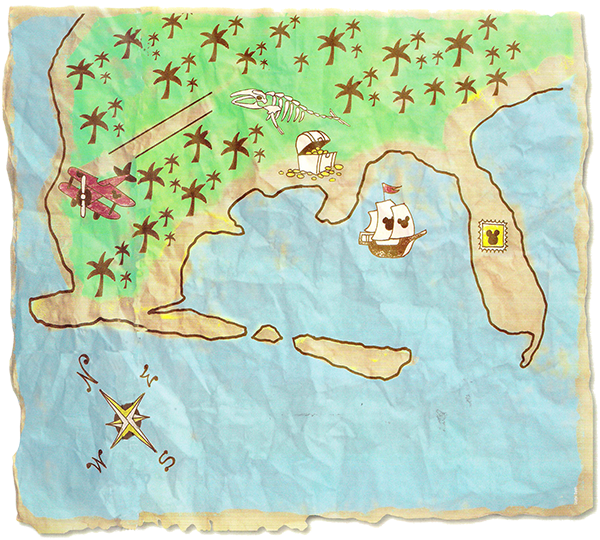
The company then moved to keep the island in line with its terrestrial parks. This began with the same kind of ruthless themed compartmentalization and programming of spaces found aboard the ships; stretches of sand that a year ago had not been there became Scuttle’s Cove, Teen Beach, Castaway Family Beach, and Serenity Beach, each for a different age group and demographic. This was followed by importing artifacts such as decommissioned rides from other Disney theme parks and sinking them in the shallows off the new beaches. In its transformation of the cay the company was continuing a practice it had perfected decades before: when the “entire ethos” of Disney was imported wholesale from Anaheim to Orlando, where the landscape of Florida was never considered anything but a thing to be “destroyed and then remade.”31
The company deployed certain architectures of disguise to conceal the island hardware (its incinerators, sewage treatment plant, telecommunications infrastructure, etc.) from view. Finally, to enforce the erasure of Gorda Cay, the company had imagineers write a counterfeit history of the island, the story of the original “castaways” of Castaway Cay. This tale—which turned out not to have much traction with Disney’s guests—is today largely sequestered within the brochures provided to each stateroom onboard the ships and reflected in the naming of other amenities throughout the island. Within a year and at an estimated cost of US$35 million, the transformation from narco-station to on-brand hermetic leisure system was complete.32
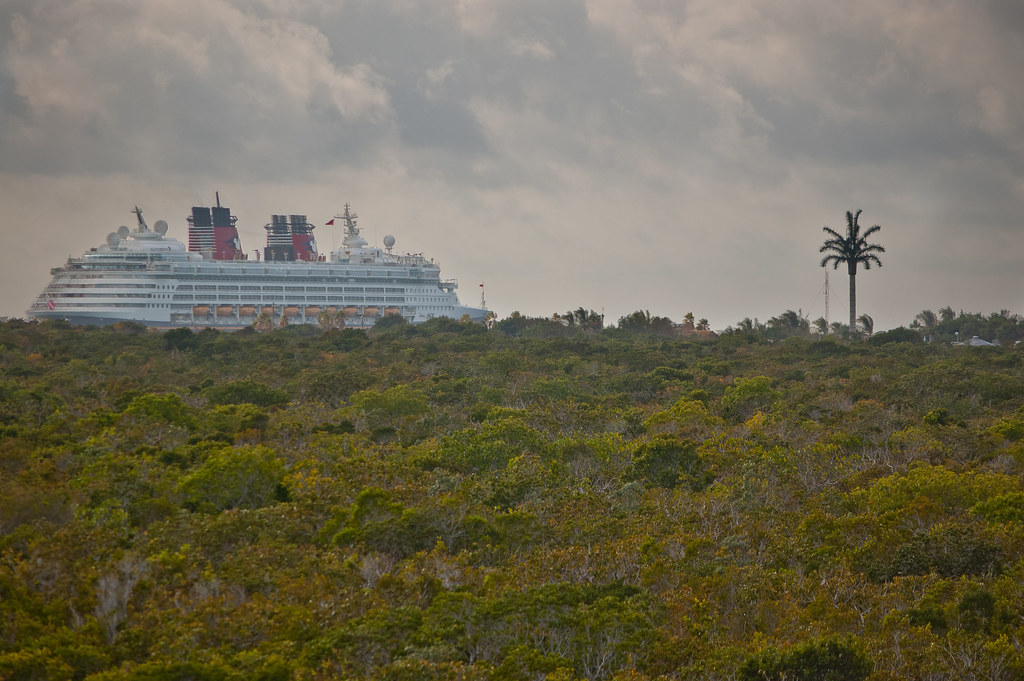
Disney’s cruise ship fleet and the development of Gorda Cay/Castaway Cay—which must be seen as two parts of the one project—have a brilliantly simple justification: to keep its customer base captive even after it has been discharged to its destination. But we might think of it another way: a method of keeping passengers still aboard the ship. Here the ship is not just the vessel but the island as well—in short, a total system to which there is no outside.
The advantages of hermeticity are obvious. It allows for an economy over which the company has complete control, one that is internally frictionless and thus more likely to yield value from customers; an experience over which it similarly has complete control, purged of spontaneity bar the weather, and thus better suited to brand continuity; and an extra-judicial environment by which the company can elude the inconveniences of US law.33 Thus as of yet, the deaths and sexual abuses of customers in Disney’s care have made little impact on the company’s brand or its Caribbean project’s capacity to continue.
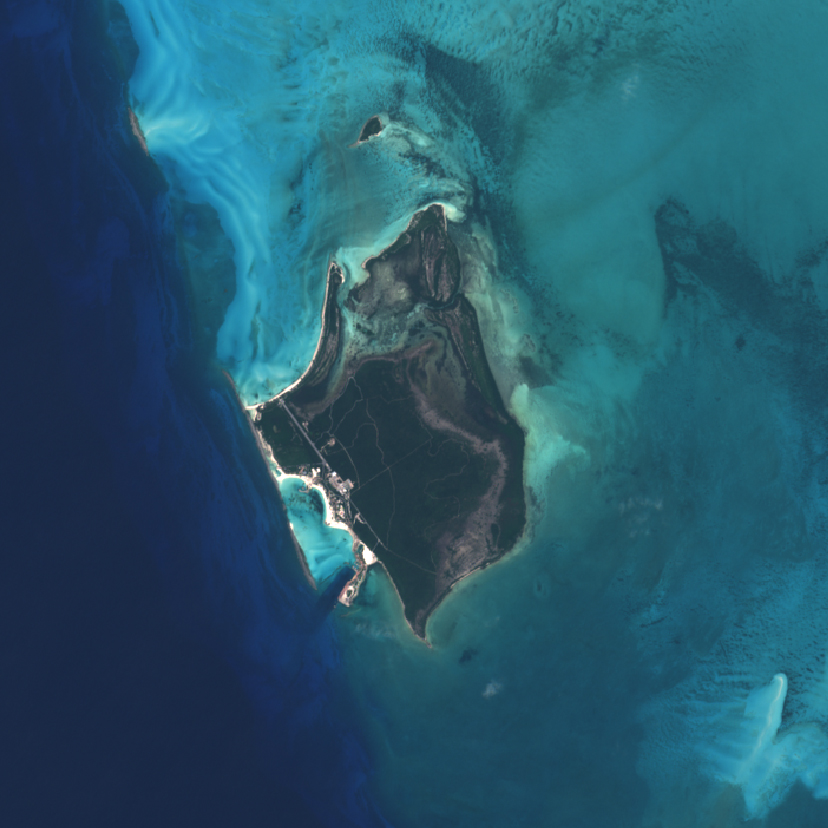
Unlike the late 1990s, today Gorda Cay’s narco past is not quite so easily concealed. A quick Google search of “Disney + drugs + island” will bring up a slew of blog posts and articles on Tucker’s airstrip or Barber’s Quaaludes. Indeed for other US ventures in the Caribbean such as Fyre, this has been a perverse selling point, a chance to party like a narco kingpin. So how is Disney’s family-friendly brand—which does not so much as allow gambling on board its fleet—remain intact?
There may be two reasons. The first is that Disney’s narrative clout and trustworthiness is somehow superior to the truth; that a company whose business model is making things up has been able to foreclose the possibility of its customers ever making the Google search above. The second is customers do not care; that they are comfortable with the mnemonic dynamiting of Gorda Cay; that there is large market after all for an “inauthentic” tourism trafficked on the decks of degenerate arks.
-
Robert E. Marx, Shipwrecks in the Americas (New York: Dover Publications, 1987), 312. ↩
-
Robert Antoni, “Blackbeard Doesn’t Come Here Anymore,” Outside magazine (January 1999), link. ↩
-
Antoni, “Blackbeard Doesn’t Come Here Anymore.” ↩
-
“US Drug Agent Accused of Smuggling Marijuana,” the New York Times, August 28, 1982, link. ↩
-
In the last year, there have been two documentaries on the Fyre Festival that have exposed one man’s defrauding not only of investors, clients, and a customer base in the US but also of the labor of black Bahamians. These productions highlight how this fraud was enabled and powered by a twin fetishization of the Bahamas’ natural beauty as well as its narco past—both politically neutralized and plied into service for the pleasure of US citizens. ↩
-
Anna Klingmann, Brandscapes: Architecture in the Experience Economy (Cambridge, MA: MIT Press, 2007), 14. ↩
-
Aaron Saunders, Giants of the Seas: The Ships That Transformed Modern Cruising (London: Seaforth Publishing, 2013), 71. ↩
-
Becky Beall, “How Disney Cruises Started,” USA Today, April 16, 2018, link. ↩
-
Jonathan Frontado, “First Look at Disney’s Next Ships,” Disney Parks Blog, March 8, 2018, (link: https://disneyparks.disney.go.com/blog/2018/03/first-look-at-disneys-next-ships](https://disneyparks.disney.go.com/blog/2018/03/first-look-at-disneys-next-ships/ text: link). ↩
-
Julie V. Iovine, “Now It’s Heigh-Ho, Off To Sea We Go,” the New York Times, January 16, 1997, link. ↩
-
Historically the process of coaling ships through hatches in the side of their hulls would leave long streaks of coal dust leeward the hatch, and they were often painted black to disguise this fact. With the shift to oil fuel and the subsequent lack of mess, ships were much more commonly painted entirely white. ↩
-
Iovine, “Now It’s Heigh-Ho, Off To Sea We Go.” ↩
-
Almost—it did serve some secondary ventilation purposes. ↩
-
Iovine, “Now It’s Heigh-Ho, Off To Sea We Go.” ↩
-
Postmodernism, as Sylvia Lavin puts it, is something like “a process, called in like a deus ex machina, to turn uncertainty into fact and ‘architecture itself’ into a myth.” Sylvia Lavin, Architecture Itself and Other Postmodernist Myths, CCA lecture, uploaded January 17, 2019, link. ↩
-
“Important Disney Acquisitions Over Time,” DisneyNews, October 30, 2018, link. ↩
-
Alan Bryman, “The Disneyization of Society,” Sociological Review, vol. 47, no. 125–126 (New York: SAGE, 1999): 29. For Disney’s labor practices, especially the rebranding of hiring and training as the production of “pixie dust,” see also Henry A. Giroux, The Mouse That Roared: Disney and the End of Innocence (New York: Rowman & Littlefield, 1999), 47–55. ↩
-
Klingmann, Brandscapes, 15. ↩
-
“Disney Dream Deck 5 Plan (Kids-Teens),” Cruise Mapper, link. ↩
-
While a ship will always be ultimately governed by a terrestrial power, once underway it is the captain—representative as he or she is of the owner—who is its sovereign. Thus the countless comparisons made between ships and sovereign parcels of land from Jules Verne to the US Navy, the literal charters given to captains of VOC ships giving them unchecked power over their charge once beyond Dutch territorial waters, or contemporary libertarian fantasies of projects such as the Seasteading Institute, in which Peter Thiel among others has previously invested, or the Freedom Ship. ↩
-
The West Edmonton Mall, as described by Margaret Crawford, represents the epitome of this particular type of heterotopia. Crawford suggests this type learned directly from Disneyland, particularly in its “spatial compression of themes…if Disneyland’s abrupt shifts of space and time suggested that to change realities could be as easy as changing channels of a television, the WEM, as one writer observed, was more like turning on all the channels at once.” Margaret Crawford, “The World in a Shopping Mall,” in Variations on a Theme Park: The New American City and the End of Public Space, ed. Michael Sorkin (New York: Hill and Wang, 1992), 3–17. ↩
-
Keller Easterling, Enduring Innocence: Global Architecture and Its Political Masquerades (Cambridge, MA: MIT Press, 2005), 1. ↩
-
Valentina Fulginiti, “Degenerate Utopias: Dystopian Revisions of Disneyland in Early Twenty-First-Century Italian Fiction,” Science Fiction Studies, vol. 44, no. 3 (November 2017): 458. ↩
-
Louis Marin, “Utopic Degeneration: Disneyland,” in Utopics (New York: Humanity Books, 1990), 239–257. ↩
-
Fulginiti, “Degenerate Utopias.” ↩
-
As primarily the instruments of late nineteenth-century and early twentieth-century empire, liners cannot be thought of as typical sites of political radicality; to the extent that they were utopian, they came at the expense of the vanquished and the poor, as all imperial utopias do. Nonetheless, they were disruptive technologies: from their role in the transport of hundreds of thousands of migrants from Europe to the US (until 1922) and to colonial possessions around the globe; to changes in labor practices as a result of the crew being in the employ of a single, powerful shipping line; to their effect on visual cultures where their sheer magnitude and cutting-edge engineering made them an obsession, not least of all for Le Corbusier, who identified the liner as a route out of architecture’s style-addled past. See Le Corbusier, Towards A New Architecture (1931), trans. Frederick Etchells (London: Dover, 1986), 103. For more on the labor of liners see Malcolm Cooper, “Maritime Labor and Crew List Analysis: Problems, Prospects, and Methodologies,” Labour/Le Travail, vol. 23 (1989): 183. ↩
-
“For the Ark is a happy myth: in it humanity stands aloof from the elements, concentrates and elaborates the necessary consciousness of its own powers, making disaster itself give evidence that the world is manageable.” Roland Barthes, Mythologies, trans. Richard Howard and Annette Lavers (New York: J Hill & Wang, 2012), 62–66. ↩
-
See the company’s newsletter for more information on this. American Bridge, Connections, Summer 2009, link. ↩
-
Amit Pinchevski and Efraim Torgovnik speak specifically about the renaming of streets, but we may apply their argument to Gorda Cay as well: “…the decision [to name] is made by political bureaucratic institutions having the legitimate monopoly to name, and as such, they hold what Pierre Bourdieu calls the ‘means of symbolic violence.’ It is therefore a political practice par excellence of ‘power over space,’ a demonstration of the scope of control vested in the political-bureaucratic institutions having the exclusive right to classify and attach definitions to an existing social space.” Amit Pinchevski and Efraim Torgovnik, “Signifying Passages: The Signs of Change in Israeli Street Names,” Media, Culture & Society, vol. 24, no. 3 (May 2002): 365–388. ↩
-
Shelton Waldrep, The Dissolution of Place: Architecture, Identity, and the Body (New York: Routledge, 2013), 41. Waldrep reminds us that it was on Discovery Island—part of Disney World’s Treasure Island section—that the biosphere disobeyed Disney’s designs, and native birds and animals set up home on the island, prompting the company to rebrand the island as a nature reserve. ↩
-
Put simply, the DOHSA (Death on the High Seas Act) protects vessels operating on the high seas from culpability for the death of passengers. ↩
Oskar Johanson ([at]merixtell_noon) is a fifth-year student at the Architectural Association, where he is a founding editor of the weekly paper PNYX and holds a BA (Dual Honours) in Fine Art & History of Art from Goldsmiths.

